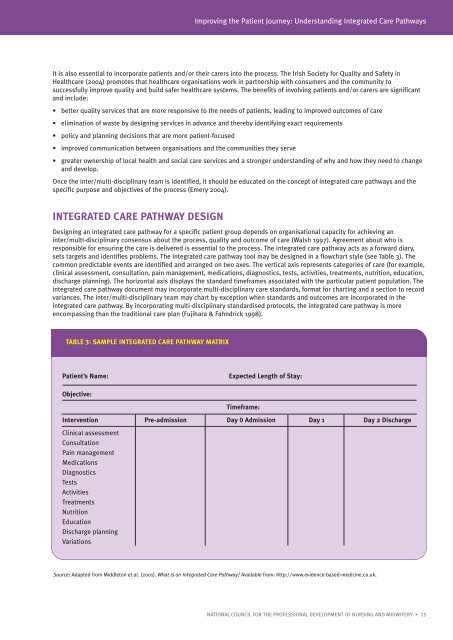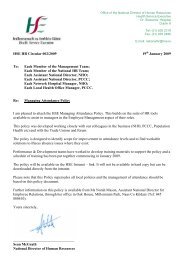SECTION 2: Key Considerations for Developing <strong>Integrated</strong> <strong>Care</strong> <strong>Pathways</strong>team can contribute to the process. The inter/multi-disciplinary teams’ active participation in the development ofintegrated care pathway development leads to increased empowerment and ownership of the product.• Development of support systems. Prior to implementing the integrated care pathway, generic pathway support systemsshould be in place. These include policies for the use of standards, generic protocols and procedures, documentationtools and the integrated care pathway.• Standardisation. Reducing variation in the process of providing a service is an effective way of improving quality. Theprocess of standardising procedures, regardless of the discipline in question, is not simple, quick, or ever fullycompleted.SELECTING AN APPROPRIATE TOPICWhen choosing an area for the development of an integrated care pathway, it is generally recommended to consider thoseassociated with high cost, high volume, predictable length of stay, clear treatment course and specific clinical outcomes.However, healthcare providers also have to consider other variables such as motivated inter/multi-disciplinary teams andprojected success. However, in the initial development with a novice inter/multi-disciplinary team, it is essential to work oncommon, familiar conditions with fairly predictable outcomes. This maximises the return on investment of staff andminimises problems of variance at a later stage (Walsh 1997). The following criteria should be considered when identifyinga topic:• common condition (high percentage of patients)• high-risk condition• problem area (with opportunities for improvement) or• preference expressed by the team (commitment is high).<strong>Integrated</strong> care pathways developed for a specific patient population will only ever be suitable for the majority. There willbe a proportion of patients within a group with specific needs that will not be met by commencing on the integrated carepathway (Panella et al. 2005).INTER/MULTI-DISCIPLINARY WORKGROUP FORMATIONA collaborative practice team is essential to developing a successful integrated care pathway (Ahmed & Harding 2005,Chilcott & Hunt 2001, Dooley & White 2003). <strong>Integrated</strong> care pathways are patient population driven, therefore, barriersbetween professional groups and departments do not reflect the holistic approach to healthcare delivery. All teammembers who are involved in the care of a particular patient population must be included in the development of theintegrated care pathway. This includes all providers of care, nurses, midwives, medical and allied staff involved in thetreatment of a particular patient group. Hussein (1998) emphasises the importance of the inter/multi-disciplinary nature ofintegrated care pathways and suggests that buy-in from various disciplines involved directly and indirectly will beenhanced by taking into consideration the following points:• every discipline is equally important, regardless of the degree of involvement• team membership should be reflective of all disciplines involved in the care delivery• team members should be empowered as champions to advocate integrated care pathways in their environment• communication on all levels is essential• standards, policies, guidelines or protocols that govern integrated care pathways must be clear and concise, outliningthe process for development, implementation and evaluation• availability of various sources of data is integral for inter/multi-disciplinary team decision-making• documentation in the integrated care pathway must be inclusive to all disciplines and not limited to nursing andmidwifery• assuring compliance with standards of regulatory agencies is essential• an important element for success is the inclusion of ancillary departments (support services)• sharing and exchanging resources across departments and services will maximise cost effectiveness, and reduceduplication and fragmentation.14 • NATIONAL COUNCIL FOR THE PROFESSIONAL DEVELOPMENT OF NURSING AND MIDWIFERY
Improving the Patient Journey: Understanding <strong>Integrated</strong> <strong>Care</strong> <strong>Pathways</strong>It is also essential to incorporate patients and/or their carers into the process. The Irish Society for Quality and Safety inHealthcare (2004) promotes that healthcare organisations work in partnership with consumers and the community tosuccessfully improve quality and build safer healthcare systems. The benefits of involving patients and/or carers are significantand include:• better quality services that are more responsive to the needs of patients, leading to improved outcomes of care• elimination of waste by designing services in advance and thereby identifying exact requirements• policy and planning decisions that are more patient-focused• improved communication between organisations and the communities they serve• greater ownership of local health and social care services and a stronger understanding of why and how they need to changeand develop.Once the inter/multi-disciplinary team is identified, it should be educated on the concept of integrated care pathways and thespecific purpose and objectives of the process (Emery 2004).INTEGRATED CARE PATHWAY DESIGNDesigning an integrated care pathway for a specific patient group depends on organisational capacity for achieving aninter/multi-disciplinary consensus about the process, quality and outcome of care (Walsh 1997). Agreement about who isresponsible for ensuring the care is delivered is essential to the process. The integrated care pathway acts as a forward diary,sets targets and identifies problems. The integrated care pathway tool may be designed in a flowchart style (see Table 3). Thecommon predictable events are identified and arranged on two axes. The vertical axis represents categories of care (for example,clinical assessment, consultation, pain management, medications, diagnostics, tests, activities, treatments, nutrition, education,discharge planning). The horizontal axis displays the standard timeframes associated with the particular patient population. Theintegrated care pathway document may incorporate multi-disciplinary care standards, format for charting and a section to recordvariances. The inter/multi-disciplinary team may chart by exception when standards and outcomes are incorporated in theintegrated care pathway. By incorporating multi-disciplinary standardised protocols, the integrated care pathway is moreencompassing than the traditional care plan (Fujihara & Fahndrick 1998).TABLE 3: SAMPLE INTEGRATED CARE PATHWAY MATRIXPatient’s Name:Expected Length of Stay:Objective:Timeframe:Intervention Pre-admission Day 0 Admission Day 1 Day 2 DischargeClinical assessmentConsultationPain managementMedicationsDiagnosticsTestsActivitiesTreatmentsNutritionEducationDischarge planningVariationsSource: Adapted from Middleton et al. (2001). What is an <strong>Integrated</strong> <strong>Care</strong> Pathway? Available from: http://www.evidence-based-medicine.co.uk.NATIONAL COUNCIL FOR THE PROFESSIONAL DEVELOPMENT OF NURSING AND MIDWIFERY • 15













